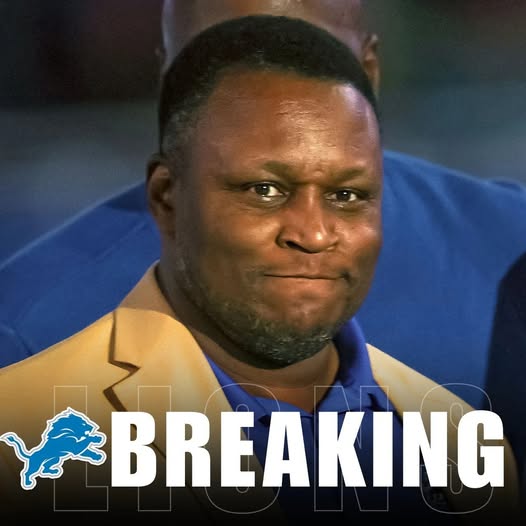The enshrinement of Barry Sanders into the Pro Football Hall of Fame is not merely a recognition of individual excellence but a celebration of an unforgettable legacy that transcends statistics and accolades. As one of the most electrifying and elusive running backs in NFL history, Sanders’ induction serves as a moment of reflection on a career that redefined the position and left fans, teammates, and opponents alike in awe of his remarkable talents.
From the moment Sanders stepped onto the NFL stage as a Detroit Lion in 1989, it was clear that he was a rare talent—one who would etch his name into the annals of football history. Standing at just 5’8″ and weighing 203 pounds, Sanders did not possess the imposing physique typical of NFL running backs. Yet, what he lacked in size, he more than made up for in agility, balance, and an uncanny ability to make defenders miss in ways that seemed almost supernatural.
Barry Sanders’ journey to the Hall of Fame began long before his NFL debut. Born in Wichita, Kansas, he honed his skills on the dusty fields of his hometown, where his dazzling speed and low center of gravity became his signature. Sanders’ collegiate career at Oklahoma State University was nothing short of legendary. In 1988, he set the college football world ablaze with a season that remains unrivaled. Rushing for 2,628 yards and scoring 37 touchdowns, Sanders claimed the Heisman Trophy and positioned himself as one of the most coveted prospects in the NFL Draft.
Selected third overall by the Detroit Lions, Sanders immediately made an impact, earning Rookie of the Year honors with 1,470 rushing yards and 14 touchdowns. His ability to stop on a dime, reverse direction, and accelerate to top speed within a few steps left defenders grasping at air and commentators searching for superlatives. In an era dominated by powerful, downhill runners, Sanders brought finesse and artistry, weaving through defenses like a masterful painter crafting a timeless masterpiece.
Throughout his ten-year career, Sanders consistently demonstrated an unparalleled combination of vision and quickness. His ability to anticipate defenders’ movements, paired with an almost preternatural sense of timing, made him virtually untouchable. Even when opposing defenses stacked the line of scrimmage, hoping to corral his elusive running style, Sanders often found a way to break free. His legendary 2,053-yard season in 1997 remains one of the most breathtaking displays of pure running talent the league has ever witnessed.
Beyond his individual brilliance, Sanders’ loyalty to the Detroit Lions remains a defining aspect of his legacy. Despite playing on teams that often fell short of championship contention, he remained committed to the city and franchise that drafted him. This unwavering dedication endeared him to fans and solidified his status as a beloved figure both on and off the field.
Sanders’ sudden retirement in 1999 shocked the football world. At the peak of his powers and just 1,457 yards shy of breaking Walter Payton’s all-time rushing record, he chose to step away from the game on his own terms. For many, it was a bittersweet moment—an acknowledgment that Sanders valued his health and happiness over the relentless pursuit of records. In his absence, the NFL was left to contemplate what might have been had he continued for just a few more seasons.
The numbers, impressive as they are, tell only part of the story. Ten Pro Bowl selections, six First-Team All-Pro honors, four rushing titles, and an MVP award in 1997 serve as testaments to his greatness. Yet it was the way Sanders played the game—fearless, graceful, and impossibly fluid—that truly set him apart. Watching Sanders navigate through defenders was like witnessing a force of nature—a whirlwind of motion that could not be contained or controlled.
For his opponents, attempting to tackle Barry Sanders was an exercise in futility. Linebackers who prided themselves on their ability to bring down even the most powerful backs found themselves grasping at shadows. Defensive coordinators devised elaborate schemes, but Sanders routinely dismantled them with a single, dazzling cutback. It was not uncommon for defenders to lose their footing entirely, deceived by his feints and hesitations.
As Sanders took the stage to accept his induction, his speech was characteristically humble and gracious. He deflected praise to his teammates, coaches, and family, attributing his success to their unwavering support. Fans watched with a sense of nostalgia, remembering the countless Sundays when Sanders transformed ordinary games into unforgettable showcases of brilliance.
The Pro Football Hall of Fame now immortalizes Sanders among the legends of the sport, where his bust will serve as a permanent reminder of what it means to play with heart, dedication, and an unyielding desire to be the best. His legacy is not merely defined by numbers or accolades, but by the way he inspired an entire generation of players to believe in the art of running.
Barry Sanders will forever be more than just a Hall of Famer. He will remain an emblem of possibility—a symbol of how passion, perseverance, and pure talent can break barriers and redefine what is possible on the gridiron. As fans continue to debate the greatest running backs of all time, Sanders’ name will always find its place among the very best, not just because of what he achieved, but because of how he did it.
With his induction, the NFL formally acknowledges what fans have known for decades—that Barry Sanders was more than just a great player; he was a phenomenon, a once-in-a-lifetime talent whose impact will resonate as long as the game endures. As his likeness takes its rightful place in Canton, Ohio, the football world pauses to remember a career that was as mesmerizing as it was legendary—a career that will never be forgotten.



